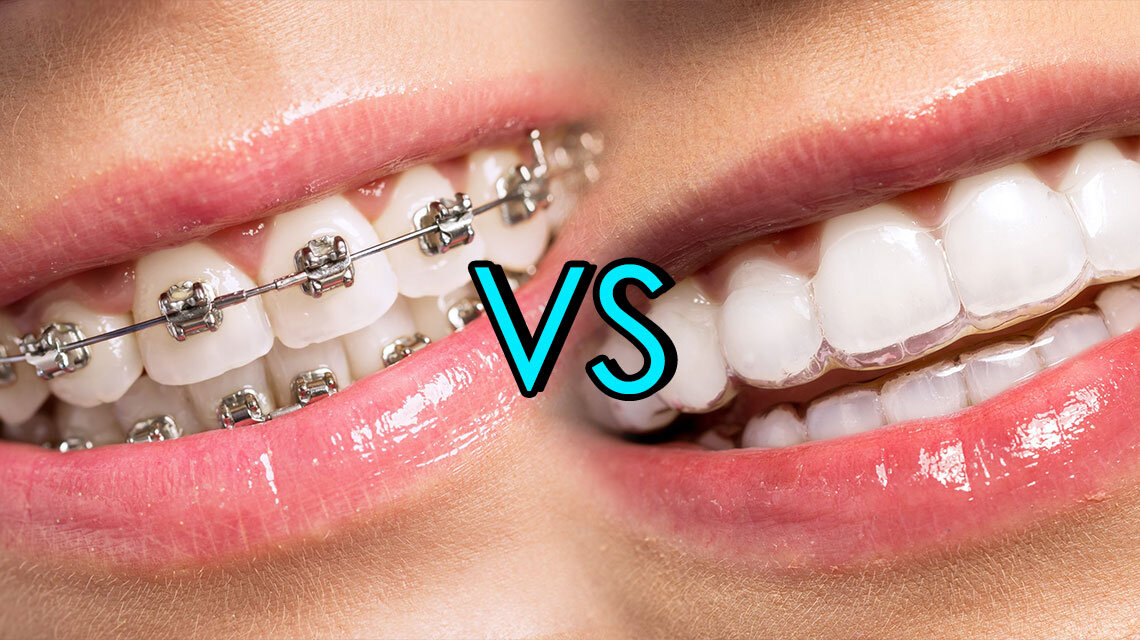The Price of Invisalign: Understanding the Investment in Your Smile
The Price of Invisalign: Understanding the Investment in Your Smile
Blog Article
Invisalign vs. Traditional Braces: Which Option Is Right for You?
When taking into consideration orthodontic treatment, the option in between Invisalign and conventional braces provides numerous essential elements that merit careful examination. Invisalign provides a very discreet option with removable aligners, while traditional braces supply an extra visible yet effective remedy for severe misalignment.
Summary of Treatment Choices

On the other hand, typical dental braces contain metal braces and cords that are bound to the teeth. This approach applies constant pressure in time to accomplish positioning. While efficient for intricate orthodontic issues, conventional dental braces need routine check outs for adjustments and can posture obstacles in keeping dental health because of the difficulty of cleaning up around braces and cords.
Both choices have their advantages, and the selection typically pivots on specific dental problems, lifestyle choices, and client compliance. Ultimately, seeking advice from an orthodontic professional is vital for figuring out one of the most appropriate therapy plan tailored to private needs. Understanding the subtleties of each option can significantly influence the overall success of orthodontic treatment.
Aesthetic Considerations
A substantial factor influencing the option between Invisalign and traditional braces is the aesthetic charm each treatment provides. Invisalign aligners are crafted from clear plastic, making them virtually undetectable when used.
On the other hand, traditional dental braces are composed of metal brackets and wires, which can be extra noticeable. While innovations in orthodontic modern technology have actually resulted in the development of smaller braces and colored elastics, conventional dental braces still maintain an even more noticeable profile. For some individuals, the presence of braces might hinder them from seeking required treatment.
Inevitably, the choice in between Invisalign and conventional dental braces may depend upon individual preferences regarding aesthetics. Individuals who focus on discernment typically lean towards Invisalign, while those that are less worried regarding visibility may choose typical braces. Comprehending the visual implications of each alternative is critical for making an educated choice that straightens with one's way of life and choices.
Comfort and Convenience

In terms of convenience, Invisalign aligners are detachable, allowing people to enjoy their favored foods without constraint and keep ideal dental hygiene. Cleaning and flossing are streamlined, as the aligners can be taken out during these regimens, whereas standard braces need careful navigating around wires and brackets.
In addition, Invisalign's progressive system permits fewer orthodontic check outs. Clients usually receive numerous collections of aligners at as soon as, which can improve the treatment procedure and decrease time spent in the orthodontist's chair. In contrast, conventional dental braces necessitate routine changes, making them less convenient for those with active routines. Invisalign. In general, the comfort and ease of Invisalign make it an attractive choice for many people looking for orthodontic treatment.
Therapy Duration and Effectiveness
While both Invisalign and typical dental braces are efficient in correcting dental imbalances, the duration of therapy can vary dramatically in between both choices. Normally, Invisalign treatment can take anywhere from 12 to 18 months, depending on the intricacy of the instance. The clear aligners work by gradually changing teeth right into their desired settings, and normal follow-ups with an orthodontist assistance make certain progression continues to be on course.
On the other hand, typical braces often call for a longer commitment, generally varying from 18 months to three years. This is due to their fixed nature and using wires and brackets, which can be extra efficient for serious imbalances and intricate situations (Invisalign). The treatment efficiency of conventional dental braces is well-documented, as they allow for accurate changes and greater control over tooth movement
Ultimately, the choice in between Invisalign and traditional check these guys out dental braces might pivot on both the anticipated treatment period and the specific dental concerns handy. Consulting with an orthodontist is crucial, as they can give customized referrals based on individual requirements, making certain the chosen method lines up with desired durations and results.
Cost Comparison and Insurance Options
Cost plays a significant function in the decision-making procedure for people considering orthodontic therapy, whether choosing Invisalign or typical dental braces. Generally, the expense of Invisalign varieties from $3,000 to $8,000, while standard braces usually cost in between $2,000 and $6,000. Variables affecting these expenses consist of the intricacy of the situation, the period of treatment, and geographical location.
Insurance insurance coverage can considerably influence out-of-pocket expenses. Many oral insurance coverage strategies provide partial protection for orthodontic treatments, however the specifics can differ widely. It is critical for individuals to review their insurance plan important link to determine the degree of insurance coverage for either alternative. Usually, standard dental braces may be more frequently covered by insurance strategies contrasted to Invisalign, which some insurance providers categorize as an aesthetic procedure.
Furthermore, several orthodontic techniques use adaptable settlement strategies, making both treatment options more available. Individuals must ask about potential funding options and discounts for upfront payments. Evaluating the overall price, consisting of insurance coverage advantages and layaway plan, is necessary for making an educated choice that straightens with both visual preferences and budget considerations.

Conclusion
In summary, the choice in between Invisalign and typical dental braces depends upon multiple factors, consisting of aesthetic preferences, convenience, therapy duration, and expense. Invisalign provides a very discreet, removable alternative that facilitates oral hygiene and nutritional versatility, while typical dental braces may be more appropriate for complicated oral problems and commonly come at a reduced rate point. Ultimately, assessment with an orthodontist is crucial to evaluate private situations and figure out the most proper treatment alternative for accomplishing ideal oral alignment.
When taking into consideration orthodontic therapy, the option in between Invisalign and typical dental braces presents a number of essential variables that warrant careful analysis.Comparing Invisalign and standard braces discloses distinctive therapy alternatives for orthodontic modification.While both Invisalign and conventional click for more info dental braces are reliable in correcting dental misalignments, the duration of treatment can vary considerably in between the 2 options.Price plays a considerable function in the decision-making process for people considering orthodontic treatment, whether deciding for Invisalign or conventional braces.In recap, the choice between Invisalign and standard braces hinges on numerous elements, consisting of aesthetic choices, comfort, treatment duration, and cost.
Report this page